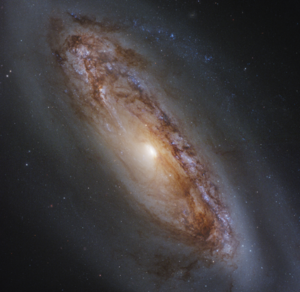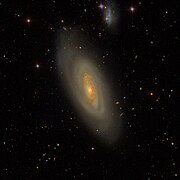| Messier 90 | |
|---|---|
 Messier 90 taken by Hubble Messier 90 taken by Hubble | |
| Observation data (J2000 epoch) | |
| Constellation | Virgo |
| Right ascension | 12 36 49.8 |
| Declination | +13° 09′ 46″ |
| Redshift | −0.000784±0.000013 |
| Heliocentric radial velocity | −235±4 km/s |
| Galactocentric velocity | −282±4 km/s |
| Distance | 58.7 ± 2.8 Mly (18.00 ± 0.86 Mpc) |
| Apparent magnitude (V) | 9.5 |
| Characteristics | |
| Type | SAB(rs)ab, LINER, Sy |
| Apparent size (V) | 9.5 × 4.4 moa |
| Other designations | |
| NGC 4569, UGC 7786, PGC 42089, Arp 76 | |
| References: SIMBAD: Search M90 | |
Messier 90 (also known as M90 and NGC 4569) is an intermediate spiral galaxy exhibiting a weak inner ring structure about 60 million light-years away in the constellation Virgo. It was discovered by Charles Messier in 1781.
Membership of the Virgo Cluster
Messier 90 is a member of the Virgo Cluster, being one of its largest and brightest spiral galaxies, with an absolute magnitude of around −22 (brighter than the Andromeda Galaxy). The galaxy is found about 1.5° from the central subgroup of Messier 87. Due to the galaxy's interaction with the intracluster medium in its cluster, the galaxy has lost much of its interstellar medium. As a result of this process, which is referred to as ram-pressure stripping, the medium and star formation regions appear severely truncated compared to similar galaxies outside the Virgo Cluster and there are even H II regions outside the galactic plane, as well as long (up to 80,000-parsec—that is, 260,000-light-year) tails of ionized gas that has been stripped away.
Star formation activity
As stated above, the star formation in Messier 90 appears truncated. Consequently, the galaxy's spiral arms appear to be smooth and featureless, rather than knotted like galaxies with extended star formation, which justifies why this galaxy, along with NGC 4921 in the Coma Cluster has been classified as the prototype of an anemic galaxy. Some authors go even further and consider it is a passive spiral galaxy, similar to those found on galaxy clusters with high redshift.
However, its center appears to host significant nebula and star formation, where around 50,000 stars of spectral types O and B that formed around 5 to 6 million years ago are set amidst many A-type supergiants that were born in earlier starbursts, between 15 and 30 million years ago.
Multiple supernovae (up to 100,000) in the nucleus have produced 'superwinds' that are blowing the galaxy's interstellar medium outward into the intracluster medium collimated in two jets, one of which is being disturbed by interaction with Virgo's intracluster medium as the galaxy moves through it.
Blueshift
The spectrum of Messier 90 is blueshifted, which indicates that, net of non-aligned vectors of motion, the gap between it and our galaxy is narrowing. The spectra of most galaxies are redshifted. The blueshift was originally used to argue that Messier 90 was actually an object in the foreground of the Virgo Cluster. However, since the phenomenon was limited mostly to galaxies in the same part of the sky as the Virgo Cluster, it appeared that this inference based on the blueshift was incorrect. Instead, many blueshifts exhibit the large range in velocities of objects within the Virgo Cluster.
Distance measurements
Low levels of H I gas prevents using the Tully–Fisher relation to estimate the distance to Messier 90.
Companion galaxies
Messier 90 is rich in globular clusters, with around 1,000 of them. The galaxy IC 3583 was once thought to be a satellite of Messier 90; however, it is now thought they are too far away to be interacting at all.
Gallery
-
 Messier 90 imaged by the Sloan Digital Sky Survey
Messier 90 imaged by the Sloan Digital Sky Survey
-
 Messier 90 imaged by GALEX
Messier 90 imaged by GALEX
See also
- List of Messier objects
- Black Eye Galaxy (Messier 64), a similar spiral galaxy
Notes
- Tschöke et al. 2001 uses a Hubble constant of 75 (km/s)/Mpc to estimate a distance of 16.8 Mpc to NGC 4569. Adjusting for the 2006 value of 70
−3.2 (km/s)/Mpc we get a distance of 18.0
−0.6 Mpc.
References
- R. W. Sinnott, ed. (1988). The Complete New General Catalogue and Index Catalogue of Nebulae and Star Clusters by J. L. E. Dreyer. Sky Publishing Corporation/Cambridge University Press. ISBN 978-0-933346-51-2.
- ^ "NASA/IPAC Extragalactic Database". Results for NGC 4569. Retrieved 1 February 2006.
- "Messier 90". SEDS Messier Catalog. Retrieved 30 April 2022.
- K. G. Jones (1991). Messier's Nebulae and Star Clusters (2nd ed.). Cambridge University Press. ISBN 978-0-521-37079-0.
- B. Binggeli; A. Sandage; G. A. Tammann (1985). "Studies of the Virgo Cluster. II - A catalog of 2096 galaxies in the Virgo Cluster area. V - Luminosity functions of Virgo Cluster galaxies". The Astronomical Journal. 90: 1681–1759. Bibcode:1985AJ.....90.1681B. doi:10.1086/113874.
- ^ "Globular Cluster Systems in Galaxies Beyond the Local Grup". NASA-IPAC Extragalactic Database (NED). Retrieved 21 July 2012.
- ^ A. Sandage; J. Bedke (1994). Carnegie Atlas of Galaxies. Carnegie Institution of Washington. ISBN 978-0-87279-667-6.
- ^ R. A. Koopmann; J. D. P. Kenney (2004). "Hα Morphologies and Environmental Effects in Virgo Cluster Spiral Galaxies". The Astrophysical Journal. 613 (2): 866–885. arXiv:astro-ph/0406243. Bibcode:2004ApJ...613..866K. doi:10.1086/423191. S2CID 17519217.
- ^ Boselli, A.; Cuillandre, J. C.; Fossati, M.; Boissier, S.; Bomans, D.; Consolandi, G.; Anselmi, G.; Cortese, L.; Cote, P.; Durrell, P.; Ferrarese, L.; Fumagalli, M.; Gavazzi, G.; Gwyn, S.; Hensler, G.; Sun, M.; Toloba, E. (2016). "Spectacular tails of ionised gas in the Virgo cluster galaxy NGC 4569" (PDF). Astronomy & Astrophysics. 587: A68. arXiv:1601.04978. Bibcode:2016A&A...587A..68B. doi:10.1051/0004-6361/201527795. S2CID 53841566.
- Bergh, S. (1976). "A new classification system for galaxies". The Astrophysical Journal. 206: 883–887. Bibcode:1976ApJ...206..883V. doi:10.1086/154452.
- Moran, S. M.; Ellis, R. S.; Smith, G. P.; Rich, R. M.; et al. (2007). "A Wide-Field Survey of Two z ~ 0.5 Galaxy Clusters: Identifying the Physical Processes Responsible for the Observed Transformation of Spirals into S0s". The Astrophysical Journal. 671 (2): 1503–1522. arXiv:0707.4173. Bibcode:2007ApJ...671.1503M. doi:10.1086/522303. S2CID 14325264.
- Gabel, J. R.; Bruhweiler, F. C. (2002). "The Central Starburst and Ionization Mechanism in the LINER/H II Region Transition Nucleus in NGC 4569". The Astronomical Journal. 124 (2): 737–750. arXiv:astro-ph/0204371. Bibcode:2002AJ....124..737G. doi:10.1086/341376. S2CID 119421698.
- ^ Chyży, K. T.; Soida, M.; Bomans, D. J.; Vollmer, B.; et al. (2006). "Large-scale magnetized outflows from the Virgo Cluster spiral NGC 4569. A galactic wind in a ram pressure wind". Astronomy & Astrophysics. 447 (2): 465–472. arXiv:astro-ph/0510392. Bibcode:2006A&A...447..465C. doi:10.1051/0004-6361:20053819. S2CID 17027396.
- ^ Tschöke, D.; Bomans, D. J.; Hensler, G.; Junkes, N. (2001). "Hot halo gas in the Virgo cluster galaxy NGC 4569". Astronomy & Astrophysics. 380 (1): 40–54. Bibcode:2001A&A...380...40T. doi:10.1051/0004-6361:20011354.
- Kenney, J. D. P.; Crowl, H.; van Gorkom, J.; Vollmer, B. (2004). "Spiral Galaxy - ICM Interactions in the Virgo Cluster". International Astronomical Union Symposium No. 217. 217: 370–375. arXiv:astro-ph/0403129. Bibcode:2004IAUS..217..370K. doi:10.1017/S0074180900197979. S2CID 18764568.
External links
- SEDS: Spiral Galaxy M90
- Messier 90 on WikiSky: DSS2, SDSS, GALEX, IRAS, Hydrogen α, X-Ray, Astrophoto, Sky Map, Articles and images
| Astronomical catalogs | |
|---|---|
| Messier | |
| NGC | |
| PGC | |
| UGC | |
| Arp | |
| Messier objects | ||
|---|---|---|
| List |
|  |
| See also | ||
| New General Catalogue 4500 to 4999 | |
|---|---|
| |